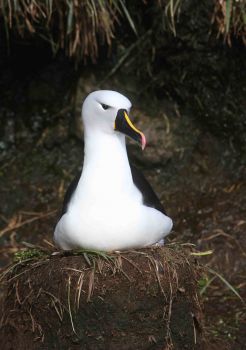Marcela Uhart (University of Californa, Davis) and colleagues have reviewed diseases affecting the 31 ACAP-listed species in the journal Bird Conservation International.
The paper’s summary follows:
"Albatrosses (Diomedeidae) and large petrels (Macronectes and Procellaria spp.) are among the world’s most rapidly declining birds. Some of the most endangered species, Amsterdam Albatross Diomedea amsterdamensis, Indian Yellow-nosed Albatross Thalassarche carteri and Sooty Albatross Phoebetria fusca, are at risk from recurrent avian cholera outbreaks. Yet little is known about the overall impact of disease in this group. We compiled all available information on pathogens described in albatrosses and large petrel species listed under the Agreement on the Conservation of Albatrosses and Petrels (ACAP) (n = 31). Available reports (n = 53) comprise nearly 60% of ACAP species (18/31). However, only 38% of them focus on threatened species (20/53), and 43% solely report macroparasite findings (23/53). Black-browed Albatross Thalassarche melanophrys [sic] (Near Threatened) and Southern Giant Petrel Macronectes giganteus (Least Concern) are the two species with higher number of publications (29/53, 55% of all papers). Conversely, seven species on the IUCN Red List have three papers or less each. Most existing research has resulted from disease or mortality investigations and baseline studies (28 and 32%, respectively). Pathogens reported in the subset of ACAP species, included bacteria in seven species (39%), viruses in five (28%), protozoa in four (22%), helminths in nine (50%), ectoparasites in 13 (72%) and fungi in one species (5%). Avian cholera, caused by the bacterium Pasteurella multocida, appears as the most severe threat to ACAP species. Infections by poxvirus are the most common viral finding, yet entail lower population level impact. Few serosurveys report pathogen exposure in these species, but add valuable baseline information. There are numerous obvious gaps in species and geographical coverage and likely under-reporting due to remoteness, accessibility and sporadic monitoring. This insufficient knowledge may be hampering effective protection and management of populations at risk. Attention to species currently affected by avian cholera is of utmost priority."

Indian Yellow-nosed Albatross - susceptible to avian cholera on Amsterdam Island, photograph by Peter Ryan
Reference:
Uhart, M.M., Gallo, L. & Quintana, F. 2018. Review of diseases (pathogen isolation, direct recovery and antibodies) in albatrosses and large petrels worldwide. Bird Conservation International 28: 169-196.
John Cooper, ACAP Information Officer, 22 June 2018

 English
English  Français
Français  Español
Español